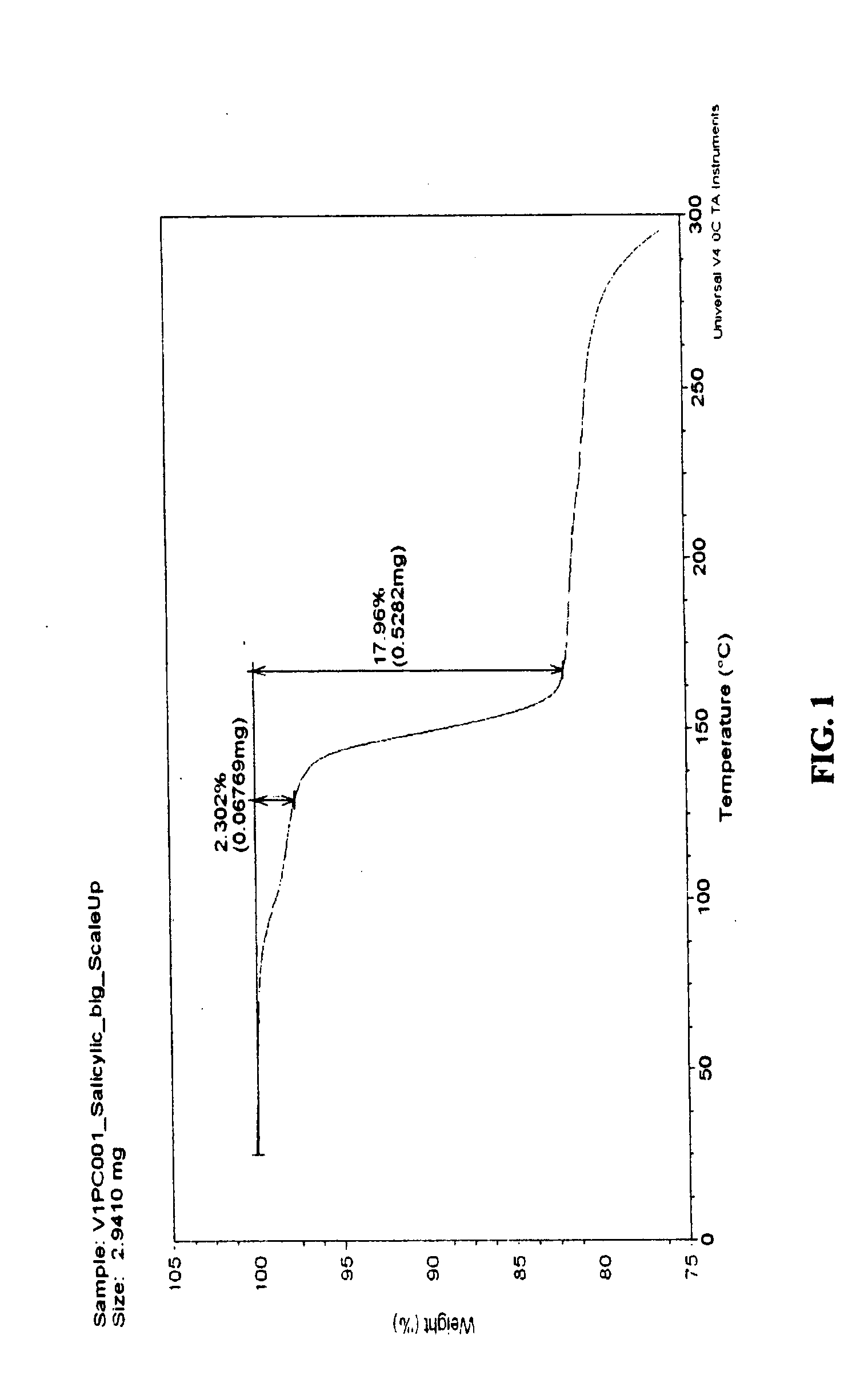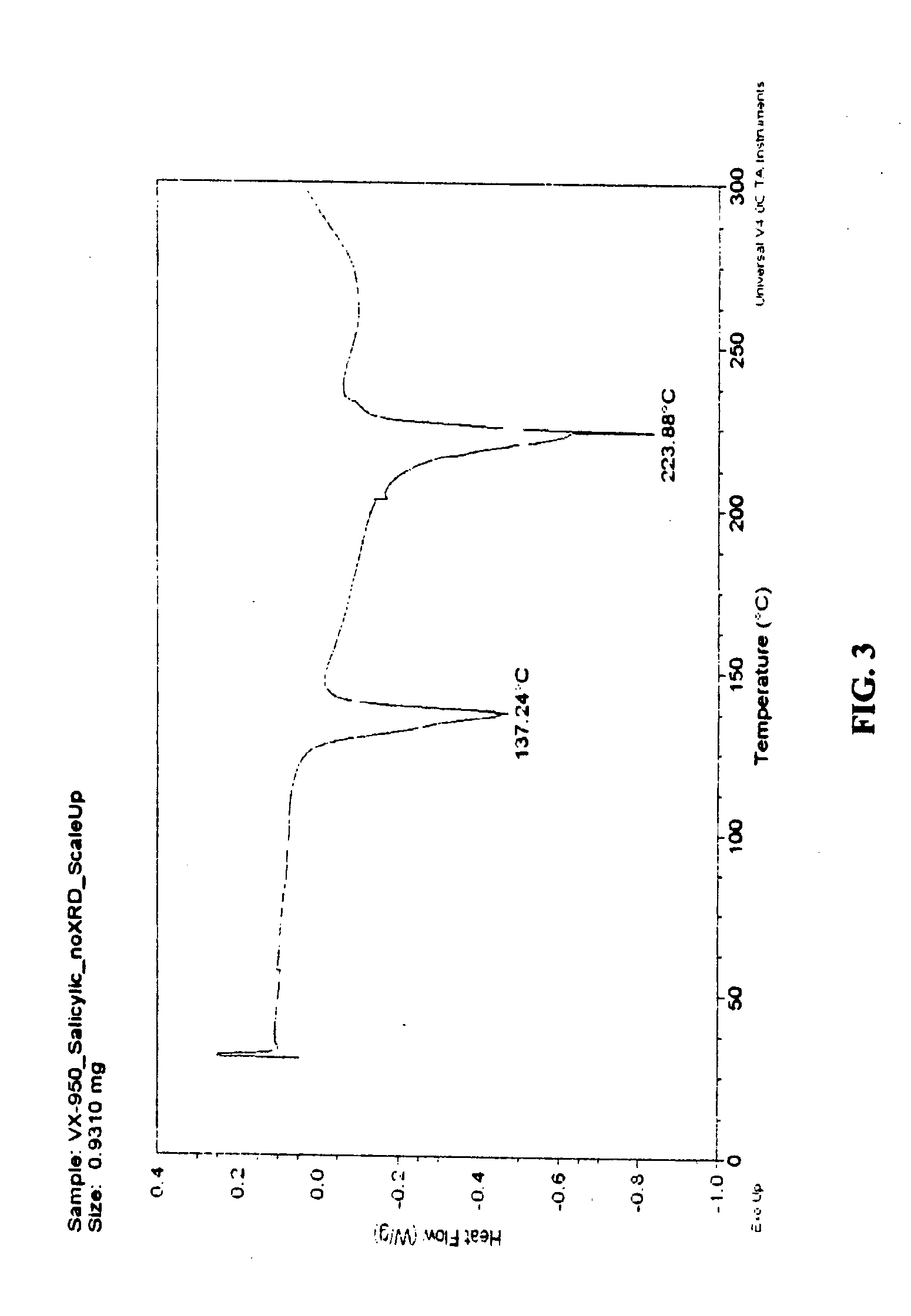Co-crystals and pharmaceutical compositions comprising the same
a technology of crystals and pharmaceutical compositions, applied in the direction of drug compositions, peptides, viruses, etc., can solve the problems of inability to broadly effective treat the debilitating inability to effectively prevent the progression of chronic hcv, and significant side effects of interferons, etc., to achieve improved dissolution, improved aqueous solubility, and improved anti-hcv vaccine prospects
- Summary
- Abstract
- Description
- Claims
- Application Information
AI Technical Summary
Benefits of technology
Problems solved by technology
Method used
Image
Examples
example 1
Preparation by Ball-Milling Method
[0041] Salicylic Acid (SA): 70 mg of VX-950 and an equal molar equivalent of SA (Sigma Chemicals Co., St. Louis, Mo., USA) as the CCF were mixed with 50 μL of methyl ethyl ketone (“MEK”). The components were milled using a Wig-L-Bug apparatus for 10 minutes. After milling, a batch was dried in a vacuum oven at 75° C. for 2 hours. The resulting material was off-white in color.
[0042] 4-Amino Salicylic Acid (4-ASA): 70 mg of VX-950 and an equal molar equivalent of 4-ASA (15.8 mg) (Sigma Chemicals Co., St. Louis, Mo., USA) as the CCF were mixed with 50 μL of acetonitrile (“ACN”). The components were then milled using a ball-mill apparatus Retsch MM200 (GlenMills Inc, Clifton, N.J.) for 3 hours at the frequency of 15 Hz. The mixture was placed in the milling compartment made of sintered corundum. After milling, the material was moved in 20-mL screw cap scintillation vial (no cap) and dried in the vacuum for 16 hours at the room temperature. After dryin...
example 2
Preparation by Melting Method
[0044] 100 mg of VX-950 and an equal molar equivalent of a CCF selected from the group consisting of salicylic acid, 4-amino salicylic acid, and oxalic acid (Sigma Chemicals Co., St. Louis, Mo., USA) were mixed by vortex for 5 minutes. This procedure was performed twice. Once it was performed without a solvent. At the second time, it was performed with 100 μL of acetonitrile, methyl ethyl ketone, and ethyl acetate for 4-amino salicylic acid, salicylic acid, and oxalic acid, respectively. The mixtures were placed in a reaction block (Radley Discovery Technologies, RR 98072) with the lid closed and heated to the endotherm. The mixtures were hold for 30 minutes at the endotherm temperature, and then the resulting mixture was cooled off under ambient conditions with the lid off, and the solvent, when used, removed.
example 3
Preparation by Solvent-Evaporation Method
[0045] VX-950 and a CCF selected from the group consisting of salicylic acid, 4-amino salicylic acid, and oxalic acid (Sigma Chemicals Co., St. Louis, Mo., USA) were dissolved separately into a solvent mixture of 50% toluene / acetonitrile. Dissolution was aided by rotation and sonication until visual clarity in the solutions was obtained. VX-950 solutions were mixed with CCF solutions in 20-mL screw cap scintillation vials at 0:1, 1:3, 1:1 and 3:1, 1:0 molar ratios in 3 mL final volumes for all. These vials were placed uncapped in a fume hood and solvents allowed to evaporate to dryness over a period of several days, to give a solid material.
PUM
| Property | Measurement | Unit |
|---|---|---|
| molar ratio | aaaaa | aaaaa |
| molar ratio | aaaaa | aaaaa |
| melting points | aaaaa | aaaaa |
Abstract
Description
Claims
Application Information
 Login to view more
Login to view more - R&D Engineer
- R&D Manager
- IP Professional
- Industry Leading Data Capabilities
- Powerful AI technology
- Patent DNA Extraction
Browse by: Latest US Patents, China's latest patents, Technical Efficacy Thesaurus, Application Domain, Technology Topic.
© 2024 PatSnap. All rights reserved.Legal|Privacy policy|Modern Slavery Act Transparency Statement|Sitemap



